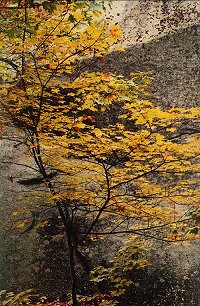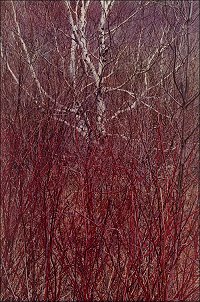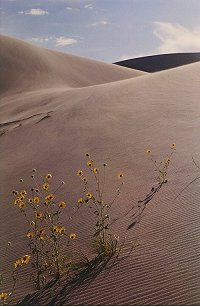Three photographs for In Wilderness portfolio:

Maple Sapling and Rock,
Passaconaway, New Hampshire, 1953

Red Osier, near Great Barrington,
Massachusetts, April 18, 1957

Sunflower and Sandune,
Colorado, 1959
I love that this reading was paired with Michael Shellenberger and Ted Nordhaus' The Death of Environmentalism. The pervasive use of Porter's aesthetic is an example of the outdated, narrow vision of environmentalism that Shellenberger and Nordhaus are calling for an end to. Though much of their discussion focused on political tactics and legislation, I think imagery and specifically photography carries a tremendous power that shapes the public's view of nature. If we are to think of Environmentalism as a culture war over our core values as Americans, as Shellenberger and Nordhaus do, imagery and photography must play a vital role in reshaping Environmentalism's vision and goals.
What might a new vision of Environmentalism look like? Here are some snapshots of the front web-pages of environmental organizations addressed in the readings:
(click to enlarge)

National Resources Defense Council

Sierra Club

The Energy Foundation

Union of Concerned Scientists

The Rainforest Action Network
This is just a sampling of the images on the front pages of these websites because all of them except The Energy Foundation have a slide show that rotates five or six main pictures. Even so, judging from these websites, I don't think that Environmentalists have shifted their vision much in the last five years. There are lots of landscapes, animal graphics and solar panels, pictures I could have predicated before I got there. When people see the pictures they expect to on these webpages, they assume the information will also be what they expect. This reinforces ingrained ideas about what Environmentalism is instead of offering new and progressive ideas.
After four wbsites of sap, I didn't expect much from the Rainforest Action Network's page but it seems more confrontational and radical that the others. I'm not sure that is the kind of vision Environmentalism needs but it does break with the technological (The Energy Foundation) and the nature lover (NRDC, Sierra Club and Union of Concerned Scientists) visualizations that front the other organizations' web pages. Oh wait, did you see that Whole Foods add? This environmental grass roots uprising (communicated by the Shepherd Ferry/Che Guevara aesthetic) is backed by Whole Foods?
Can artists offer a better vision than the environmental organizations? These two readings seem like a challenge from Judy and Greg to find artists that do just that. Some obvious answers are Burtysky, Gursky and maybe Richard Misarch. We talked a lot about Terry Evans but I'm not convinced that her images have as much political punch as we gave them credit for last week. Chirs Jordan's work on consumerism also comes to mind.

Chris Jordan - Circuit boards #2, New Orleans 2005
Also Rodney Graham (am I stretching here?) By flipping pictures of trees upside down, Rodney Graham emphasizes one of the ways the camera abstracts the thing it is photographing. Nature through a camera lens isn't subject to the same laws of gravity and vision as nature in the tangible world.

Rodney Graham - Napoleon Tree, 1996
No comments:
Post a Comment